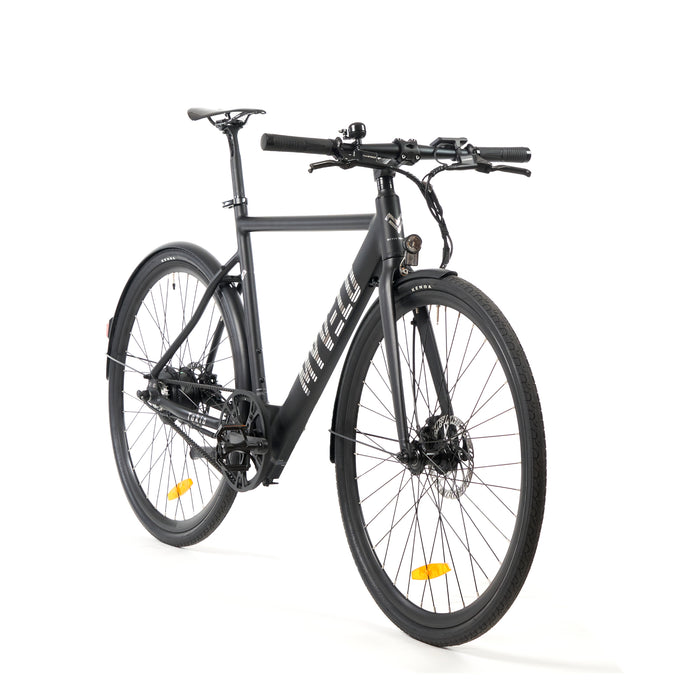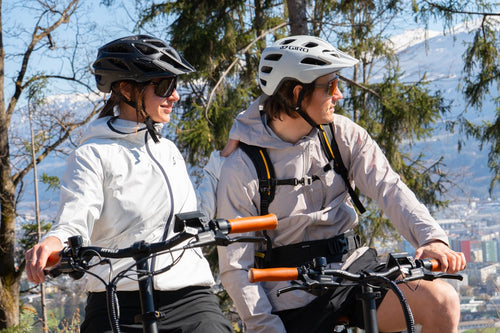
Tokio Singlespeed E-Bike
incl. FREE shipping & free returns

The trend sport of e-bike riding is booming. On German roads you see more and more private e-scooters that require road approval. However, different rules apply for e-racing bikes: Pedelecs can be ridden on roads or cycle paths without a license plate.
Von Vincent Augustin |
3 minutes read time


Vincent founded MYVELO together with Fabian. The two share a long-standing passion for cycling. Together they have cycled thousands of kilometers and fought for victories in the German racing bike league. The idea of founding MYVELO arose from their many years of experience and knowledge of what makes a good bike. Find out more about MYVELO now
Published: November 27, 2020 | Updated: June 17, 2025
E-racing bikes are versatile. The electric motor supports you not only on straight stretches, but also on inclines in the city or in the countryside. Unlike e-scooters, which are only powered by a motor, you can use the motor on e-racing bikes to provide support as you wish. It is therefore not necessary to use the motor for the entire journey.
The range of the e-racing bike depends on how often you use the electric motor. The longer the motor is switched on, the faster the battery will be empty. Weight also plays a role: additional load, be it a heavy backpack or shopping, affects the performance of the motor and the battery life.
Since the new electromobility guidelines of 2019, drivers of electric scooters are allowed to participate in road traffic without a driver's license. E-bikes and e-scooters are considered bicycles and must meet the appropriate safety precautions such as lighting, brakes and mudguards. Unlike in the Netherlands, the lighting must be attached to the bicycle, not the driver.
To ride an e-racing bike at speeds of up to 45 km/h, you need a class AM driving license. Children aged 12 and over are allowed to ride on the road, provided the e-bike is throttled and does not exceed a maximum speed of 12 km/h. There is no helmet requirement, but lights and mudguards are required, as with conventional bicycles.
Legally, there is an important difference: an e-bike can also be ridden without pedaling and therefore requires at least a class M driving license. A pedelec, on the other hand, only supports your own pedaling power and is therefore classified as a bicycle, meaning that it can be ridden without a license. When buying, make sure that the maximum power of the motor is approved in Germany. For fast e-racing bikes with 45 km/h, this is 4,000 watts, while electric bikes that do not require a license can reach a maximum speed of 25 km/h.
An e-racing bike can be very useful for long bike tours or particularly hilly routes. Make sure you know the legal regulations so that you can ride stress-free. Violations of the road traffic regulations can have far-reaching consequences, such as revocation of your driving license if you drive an e-racing bike while under the influence of alcohol or an MPU for new drivers.
Your riding style affects the range of your battery. Don't use the motor all the time and ride at a lower speed to get further. Less wind resistance and appropriate clothing can also increase the range.
Make sure that the electric motor is protected from moisture. Avoid driving through puddles and protect the motor with a plastic bag when it rains. In winter, the e-bike should be brought into the garage or house, as the cold damages the battery. A waterproof protective cover protects the bike when it is outside. During the warranty period, the motor can be repaired free of charge; later, it is considered a wearing part and may have to be replaced at your own expense.
E-road bikes are lighter than other e-bikes in order to achieve the desired high speeds. The seating position and
The handlebars are designed like those of conventional racing bikes, which makes them less suitable for leisurely cruising around town. The electric motor is also lighter to keep the overall weight of the bike low. High-quality and smooth-running components mean that e-racing bikes are often more expensive than other electric bikes, although there are different price ranges depending on the manufacturer.
If you want to travel abroad with your e-racing bike, find out about the local regulations on electromobility beforehand. These can vary from country to country. What is permitted in Germany may be prohibited or restricted in other countries.
E-racing bikes offer a great way to tackle long and challenging routes effortlessly. They combine the advantages of a classic racing bike with the support of an electric motor. Pay attention to the legal regulations and take proper care of your e-racing bike to enjoy it for a long time. Whether for sporting challenges or relaxed tours - an e-racing bike can be a worthwhile investment.
Lass Dich von Fahrrad-Enthusiasten beraten
Die Antwort hängt davon ab, wie schnell das E‑Rennrad fährt. Grundsätzlich unterscheidet man zwischen Pedelecs (bis 25 km/h) und S-Pedelecs (bis 45 km/h):
Gelten rechtlich als Fahrräder. Für sie brauchst du weder Führerschein noch Zulassung, und du darfst auf Radwegen fahren. Ein E‑Rennrad mit bis zu 250 Watt Motorleistung fällt unter diese Kategorie sind dagegen rechtlich gesehen Kleinkrafträder
Für den Großteil der E‑Rennräder auf dem Markt reicht ein normales Fahrrad-Setup ohne Führerschein. Wer jedoch mit einem E‑Rennrad regelmäßig die 45 km/h Unterstützung nutzen möchte, muss die oben genannten Vorgaben beachten. Wichtig: Diese Regelungen gelten für Deutschland – in anderen Ländern können andere Vorschriften gelten.
Tipp: Achte beim Kauf auf die genaue Angabe zur Motorunterstützung. Wenn du unsicher bist, ob ein Modell führerscheinpflichtig ist, frage beim Händler oder direkt beim Hersteller nach.
Die Akkulaufzeit eines E‑Rennrads hängt von verschiedenen Faktoren ab – pauschale Aussagen sind schwierig. Typische Reichweiten liegen bei 60 bis 150 Kilometern pro Akkuladung. Folgende Punkte beeinflussen die Reichweite maßgeblich:
- (gemessen in Wattstunden, Wh): Ein 250 Wh Akku hält deutlich kürzer als ein 500–700 Wh Modell. Die meisten hochwertigen E‑Rennräder haben Akkus zwischen 250–500 Wh.
- Wer dauerhaft auf maximaler Unterstützung (z. B. „Turbo-Modus“) fährt, leert den Akku schneller. Im „Eco“-Modus kann sich die Reichweite verdoppeln.
- Bergige Strecken, häufiges Anfahren oder starkes Gegenwindfahren verlangen mehr Energie vom Motor. Flaches Gelände mit gleichmäßigem Tritt ist effizienter.
- Mehr Gewicht = mehr Energiebedarf.
Kälte reduziert die Akkuleistung teils drastisch. Zudem altern Akkus über die Jahre.
Ein realistisch genutztes E‑Rennrad mit 500 Wh Akku schafft im Mischbetrieb meist etwa 80–120 km. Wer längere Touren plant, kann über einen Zweitakku oder ein Range Extender System nachdenken.
Ja, definitiv – E‑Rennräder sind längst nicht mehr nur eine Lösung für „unsportliche Radler“. Im Gegenteil: Moderne E‑Rennräder sprechen gezielt sportliche Fahrer an, die Unterstützung in bestimmten Situationen suchen.
Ein sportliches E‑Rennrad bringt je nach Modell nur ca. 12 bis 16 kg auf die Waage – das ist nur wenig mehr als ein Carbon-Rennrad mit Gepäck. Viele Hersteller setzen auf kompakte, kaum sichtbare Motoren, die sich nahtlos ins Rahmendesign einfügen.
Die Unterstützung ist oft fein dosierbar. Du entscheidest, wann du Power brauchst – und kannst auch komplett ohne Motor fahren. Das sorgt für ein realistisches, sportliches Fahrgefühl mit Zusatzschub bei Bedarf.
Gerade für ältere Sportler, Wiedereinsteiger oder ambitionierte Tourenfahrer ist ein E‑Rennrad ideal. Es ermöglicht längere Touren, schnelleres Tempo oder gemeinsame Ausfahrten mit fitteren Partnern.
Fazit: Wer sportlich fahren will, aber nicht immer 100 % der Leistung bringen möchte oder kann, für den ist ein E‑Rennrad die perfekte Lösung – ohne schlechtes Gewissen.






Nur für Abonnenten: Erhalte exklusive Insights, Profi-Tipps und Angebote, die sonst keiner bekommt. Melde Dich an und sichere Dir Rabatt auf MYVELO Gear!
Added to your cart:



